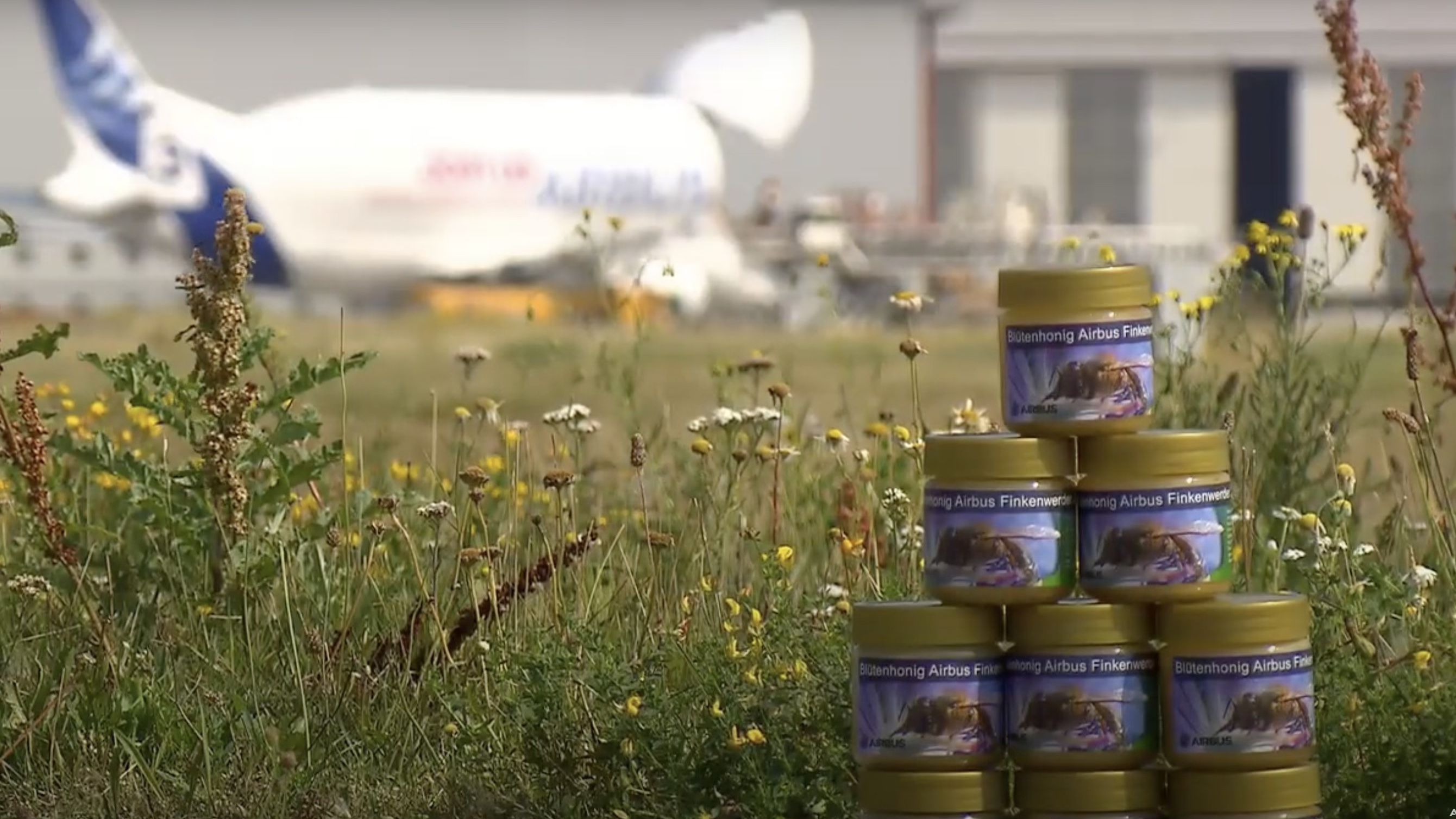Summary
- Airbus bees help monitor emissions at Hamburg Airport and provide positive pollutant findings with their honey.
- Hamburg Airport is cooperating with the German Wildlife Foundation to strengthen bee populations and habitats.
- Hamburg Airport has set itself the goal of reducing CO2 emissions and becoming CO2-neutral in 2021.
It’s not just planes that fly around Hamburg Airport. For 25 years, bees have been helping to monitor emissions around the airport.
Start of operations for the beehives at Hamburg Airport
In 1999, Airbus, conscious of its environmental impact, launched a project to collect honey from beehives set up at the airport near the Airbus paint shop and next to the runway where the company carried out test flights. The honey provided information on the soil, water and air quality of the surrounding areas.
The bees collect pollen and nectar from hundreds of thousands of flowers in the area. An independent laboratory analyses the honey produced, and the results of the honey analysis are consistently positive. Chemical deposits in the flowers were detected in the honey, and the laboratory tests show that the pollution levels are no higher than outside the Airbus site and even lower than in downtown Hamburg.
Tens of thousands of Airbus bees produce over 160 kilograms of honey every year. The honey is not sold, but given to customers, suppliers, Airbus employees and their families.
In the last 25 years
Since 2015, the FHG has been involved in the Hamburg Airport bee project, which was initiated by the German Wildlife Foundation to combat the decline in the community bee population in Germany. Flower strips have been planted on the airport grounds to serve as a habitat and place of refuge for the bees.
Eight bee colonies are located near the runways. They also provide indicators of the quality of the air, soil and flora. The pollen collected by the bees and the honey they produce are tested for pollutants.
German Wildlife Foundation
The habitat for wild bees and other insects is becoming scarce, and there are no food sources or nesting opportunities. The German Wildlife Foundation is committed to protecting wild bees in urban areas. In Hamburg and Berlin, it creates habitats for insects. It also informs citizens and authorities about what they can do in practice to combat species loss and advises project partners on the creation of wild bee-friendly green spaces and biotopes.
It began in Hamburg in 2015, where two committed partners, the Ohlsdorf Cemetery and Hamburg Airport, sowed flower meadows, laid nesting substrates, examined wild bees and derived further care steps. Since then, the German Wildlife Foundation has improved over 190,000 square meters for wild bees.
Hamburg Airport focuses on reducing CO2 emissions
Hamburg Airport was the first major commercial airport in Germany to achieve this goal of CO2-neutral operations in 2021. Hamburg Airport sees the building blocks of CO2-neutral airport operations in reduced energy consumption, innovative technologies, nature conservation projects and high-quality offset certificates.
Hamburg Airport keeps climate protection firmly in mind with every new facility, every project and every acquisition. By investing in the latest technology, renewable energies and synergies, Hamburg Airport is securing its CO2-neutral operations for the future. In the long term, the airport is pursuing the goal of completely avoiding carbon dioxide emissions.
Other airport beekeepers
Hamburg Airport was the first airport to use bees to study its emissions. Many airports around the world have done the same. Because airports are usually surrounded by land to block out noise, they are usually considered unsuitable for residential and commercial use. However, land is perfect for housing beehives.
“By introducing beehives, airports can now easily monitor their emissions and overall carbon footprint, allowing them to assess their impact on the environment while making a positive contribution to biodiversity in their surroundings,” said Planbee.
In the United States alone, there are beehives at nearly 20 airports, including Wright-Patterson Air Force Base. The base has three apiaries with 16 colonies. The hives are surrounded by an array of wildflowers, and each colony consists of 30,000 to 80,000 honey bees.
In 2014, when the son of Karen Levin, executive director of the Levin Foundation, realized that honey bee habitat in Ohio and the Midwest was under threat, she decided to create Propolis Projects under the umbrella of the foundation. Ohio is home to more than 500 different species of native bees. Honey bees pollinate over 65% of food crops.
Over the past 25 years, Hamburg Airport, in collaboration with Airbus and the German Wildlife Foundation, has used bees as bioindicators to monitor environmental emissions, with positive results in terms of pollution levels. In 1999, Airbus initiated a project to install beehives at the airport. Honey analysis showed lower levels of pollution compared to the city center. This innovative approach continues to help monitor environmental health and supports the dwindling bee population by creating habitat.
In 2021, Hamburg Airport reached a milestone: it became the first major commercial airport in Germany to become carbon neutral, underlining its commitment to climate protection. The practice of using airport land for beehives has gained international popularity and represents a sustainable way for airports to monitor emissions and support biodiversity.

